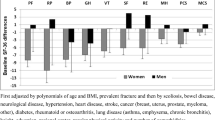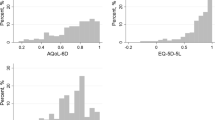Abstract:
The objective of the study was to test an instrument for measuring health-related quality of life (HRQL) for women with osteoporosis and back pain caused by vertebral fractures related to osteoporosis. A longitudinal cohort study design was used in which women were seen at baseline, after 2 weeks, and after 6 months. The setting was a secondary care rheumatology practice in Canada and four separate secondary care metabolic bone disease practices in the United States. The patients were 226 women suffering from osteoporosis and back pain with a mean bone mineral density of 0.84 ± 0.14 g/cm2 and a mean of 2.78 (median 2, range 1–11) vertebral fractures. We administered the Osteoporosis Quality of Life Questionnaire (OQLQ) with 30 items distributed across five domains: Symptoms, Physical Function, Activities of Daily Living, Emotional Function, and Leisure. In addition, we administered the Sickness Impact Profile (SIP), the 36-item short form of the Medical Outcomes Survey instrument (MOS SF-36), and the Brief Pain Inventory (BPI). On the basis of what women told us about the areas of their lives adversely affected by their osteoporosis, we constructed OQLQ. Reliability coefficients between baseline and 2-week follow-up varied from 0.80 to .089 for the five domains. Cross-sectional correlations between OQLQ domains and other measures were consistently higher than predicted (0.51–M0.81). The OQLQ proved to be as powerful or more powerful than alternative instruments for detecting improvement or deterioration in patients whose status changed. Sample sizes of less than 150 per group should be required to detect minimally important differences in parallel-group clinical trials. Longitudinal correlations between OQLQ and other measures were generally lower than predicted. This may be due to limitations in either the OQLQ or the other instruments. It is concluded that the OQLQ may prove to be a useful instrument for discriminating between women with different levels of impaired HRQL,, and for evaluating change in women undergoing treatment for back pain related to osteoporosis.
Similar content being viewed by others
Author information
Consortia
Rights and permissions
About this article
Cite this article
Osteoporosis Quality of Life Study Group. Measuring Quality of Life in Women with Osteoporosis. Osteoporos Int 7, 478–487 (1997). https://doi.org/10.1007/PL00004151
Issue Date:
DOI: https://doi.org/10.1007/PL00004151




